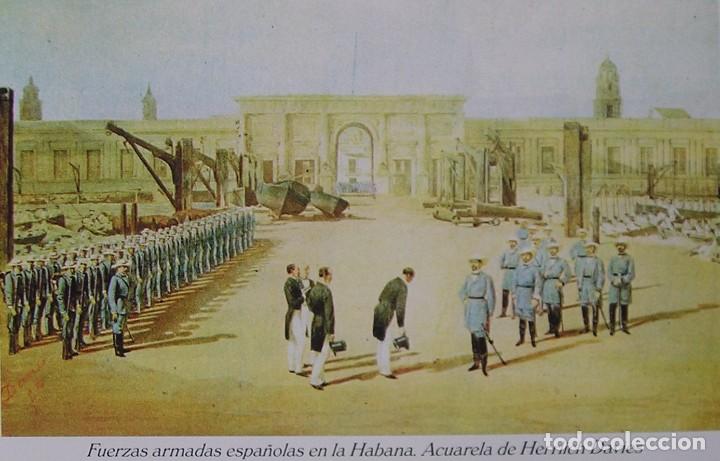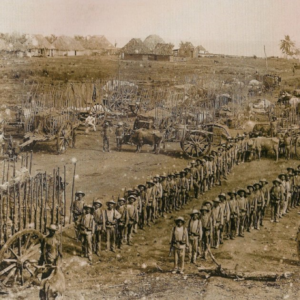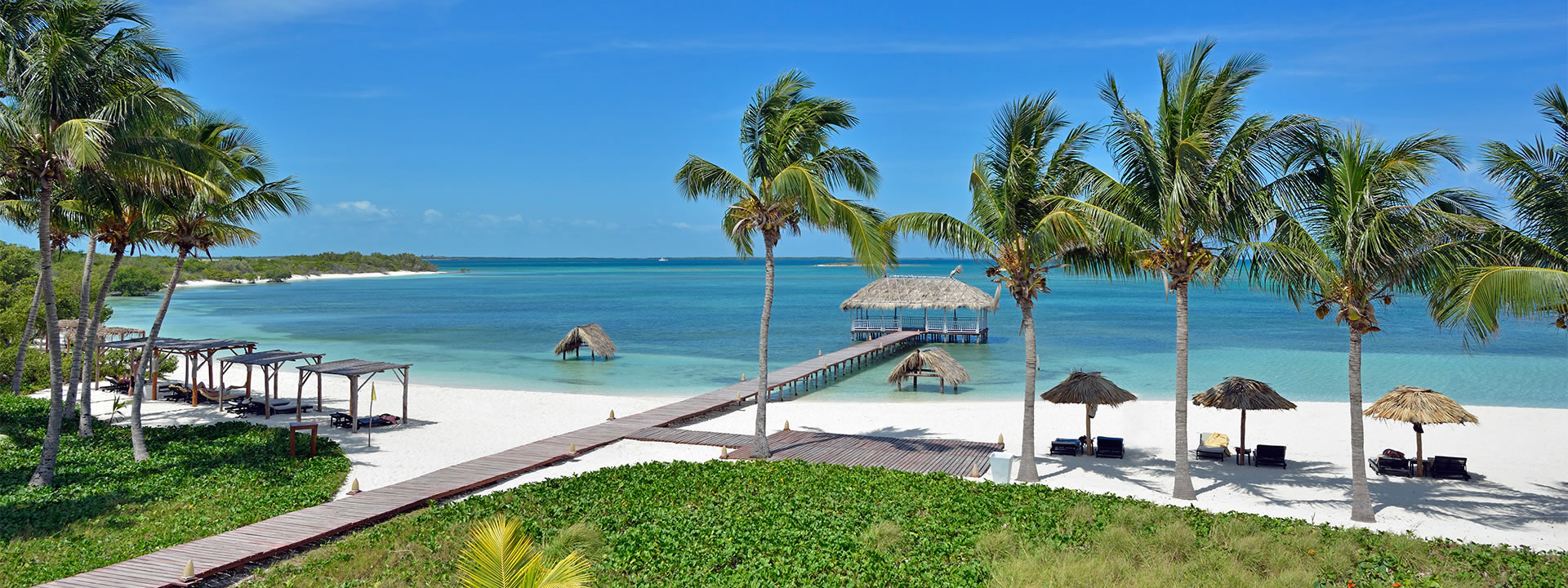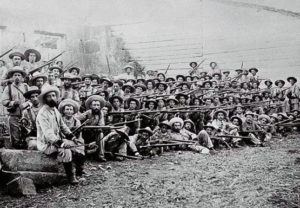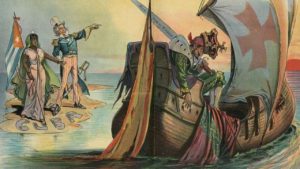 NORTEAMERICA Y LOS CUBANOS CUANDO ESPAÑA ABANDONÓ A CUBA (1898).
NORTEAMERICA Y LOS CUBANOS CUANDO ESPAÑA ABANDONÓ A CUBA (1898).
La guerra hispanoamericana fue un conflicto armado entre España y los Estados Unidos en 1898. Las hostilidades comenzaron a raíz de la explosión interna del USS Maine en el puerto de La Habana en Cuba , lo que lleva a la intervención de Estados Unidos en la Guerra de Independencia de Cuba. La guerra condujo al surgimiento del predominio de los EE.UU.
El resultado fue el Tratado de París de 1898, sin presencia de los patriotas cubanos, fue negociado en términos favorables para los EE.UU. Que le permitieron el control temporal de Cuba y cedieron la propiedad de Puerto Rico, Guam y las islas Filipinas. La derrota y la pérdida de los últimos restos del Imperio español fue un profundo shock para la psique nacional de España y provocó una profunda reevaluación filosófica y artística de la sociedad española conocida como la Generación del ’98.
CUANDO ESPAÑA ABANDONO A CUBA.
La ceremonia fue breve. En la plaza de armas del Palacio de la Capitanía General en La Habana formaban las tropas españolas y norteamericanas. En el salón estaban los generales de ambos bandos.
Con la primera campanada de las 12 se oyó el primero de los 21 cañonazos. Después, en medio del silencio, el general Jiménez Castellanos, último capitán general y gobernador español de Cuba, con lágrimas y voz enérgica, ante el general norteamericano Brooke, dijo: «Caballeros, en cumplimiento del Tratado de París, del convenio con las comisiones militares de la isla y las órdenes de mi rey, en este momento, mediodía de primero de enero de 1899, cesa en Cuba la soberanía española y empieza la de Estados Unidos». Tras la contestación de Brooke, los españoles se retiraron a los muelles para embarcar. A esa misma hora la última bandera española que ondeaba en América, en el Morro de La Habana, fue arriada y sustituida por la norteamericana.
Entregada La Habana, en los días siguientes, el general Castellanos continuó de forma ordenada con la repatriación de las fuerzas españolas reconcentradas en Matanzas y en Cienfuegos. Al mismo tiempo, tras reorganizar las finanzas y vender pertrechos, consiguió pagar los atrasos a los soldados y al personal civil: llevaban meses sin cobrar su sueldo íntegro, que solo recibían los altos cargos; también consiguió traer en oro más de dos millones de pesos para el Tesoro.
El último reembarco se hizo desde Cienfuegos en el vapor ‘Cataluña’. Partió de Cuba el 6 de febrero con el general Castellanos y 1.294 militares, fondeando en A Coruña a las siete de la mañana del 20.
LAS TROPAS REGRESARON DIEZMADAS POR LOS CUBANOS Y LAS ENFERMEDADES.
Numeroso público acudió a recibirlo, ya que en él regresaba casi todo el batallón de cazadores de Reus, compuesto en su mayoría por gallegos y perteneciente a la guarnición coruñesa desde 1878. Venían 417 hombres de la primera, tercera, quinta y sexta compañía, además de la charanga; las otras dos compañías ya habían regresado antes por Vigo. Habían partido para Cuba el 21 de agosto de 1895, en medio del entusiasmo popular, y ahora retornaban diezmados por las bajas de guerra y enfermedades en un ambiente pesimista sobre la esencia y el futuro de España. Según La Voz de Galicia regresaban «escasamente la mitad de los soldados que fueron»; hasta su banda, muy querida en la ciudad, venía deshecha.
Su desembarco comenzó a las 10, terminando una hora y media más tarde. Después, en formación marcharon hacia su cuartel, el de Alfonso XII (hoy Atocha). Partieron con su uniforme y equipo militar y ahora desfilaban vestidos con traje y gorra de paisano.
Por las calles Real, Rego de Auga y plaza de María Pita, sus filas se deshacían a menudo por los que presenciaban su paso y se abalanzaban, tras reconocerlos, para abrazar emocionados a parientes, amigos o conocidos. Estaban sanos y salvos. El Cataluña continuaría su viaje hasta Santander donde llegó el 22, desembarcando el general Castellanos y 697 hombres, la mayoría del batallón de cazadores de Llerena de servicio en Vitoria.
Finalizaba la repatriación y la sangría de Cuba.
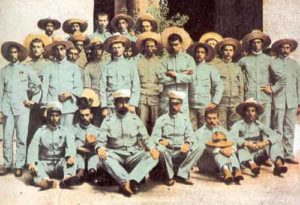 NORTH AMERICA AND THE CUBANS WHEN SPAIN ABANDONED CUBA (1898).
NORTH AMERICA AND THE CUBANS WHEN SPAIN ABANDONED CUBA (1898).
The Spanish-American War was an armed conflict between Spain and the United States in 1898. The hostilities began following the internal explosion of the USS Maine in the port of Havana in Cuba, leading to the intervention of the United States in the War of Independence of Cuba The war led to the emergence of US dominance.
The result was the Treaty of Paris of 1898, without Cuban patriots present, was negotiated in favorable terms for the US. They allowed him temporary control of Cuba and ceded ownership of Puerto Rico, Guam and the Philippines. The defeat and loss of the last remnants of the Spanish Empire was a profound shock to the national psyche of Spain and caused a profound philosophical and artistic reevaluation of the Spanish society known as the ’98 Generation.
The ceremony was brief. The Spanish and North American troops formed in the main square of the Palace of the Captaincy General in Havana. In the hall were the generals of both sides.
With the first bell of 12 o’clock, the first of the 21 gunshots were heard. Then, in the midst of silence, General Jiménez Castellanos, the last Spanish general captain and governor of Cuba, with tears and energetic voice, before the American general Brooke, said: «Gentlemen, in compliance with the Treaty of Paris, of the agreement with the commissions military of the island and the orders of my king, at this time, noon of January 1, 1899, the Spanish sovereignty ceases in Cuba and begins that of the United States ». After Brooke’s reply, the Spanish withdrew to the docks to embark. At that same time, the last Spanish flag flying in America, in the Morro de La Habana, was lowered and replaced by the American one.
Delivered Havana, in the following days, General Castellanos continued in an orderly manner with the repatriation of the Spanish forces re-concentrated in Matanzas and Cienfuegos. At the same time, after reorganizing the finances and selling supplies, he managed to pay the arrears to the soldiers and civilian personnel: they had not paid their full salary for months, which only received the high positions; He also managed to bring in gold more than two million pesos for the Treasury.
The last landing was made from Cienfuegos in the steam ‘Catalonia’. He left Cuba on February 6 with General Castellanos and 1,294 soldiers, anchoring in A Coruña at seven in the morning of the 20th.
THE TROPS RETURNED DECIMATED BY THE CUBANS AND THE DISEASES .

Numerous public came to receive it since it returned almost the entire battalion of hunters of Reus, composed mostly of Galicians and belonging to the Corunna garrison since 1878. There were 417 men of the first, third, fifth and sixth company, in addition to the charanga; the other two companies had already returned before for Vigo. They had left for Cuba on August 21, 1895, amid popular enthusiasm, and now returned decimated by the casualties of war and disease in a pessimistic environment about the essence and future of Spain. According to La Voz de Galicia, “half of the soldiers who were” returned scarcely; even his band, very dear in the city, came undone.
His landing began at 10, ending an hour and a half later. Then, in formation they marched to their headquarters, that of Alfonso XII (today Atocha). They left with their uniform and military equipment and now paraded dressed in civilian clothes and hats.
Through the streets Real, Rego de Auga and Maria Pita square, their ranks were often undone by those who witnessed their passage and pounced, after recognizing them, to embrace excited relatives, friends or acquaintances. They were safe and sound. Catalonia would continue its trip to Santander where he arrived on the 22nd, disembarking General Castellanos and 697 men, most of the battalion of Llerena hunters on duty in Vitoria.
The repatriation and the bleeding of Cuba ended.
Agencies/ La Voz de Galicia/ Xose Alfeiran/ Wiki/ Internet Photos/ Arnoldo Varona/ www.TheCubanHistory.com
THE CUBAN HISTORY, HOLLYWOOD.



